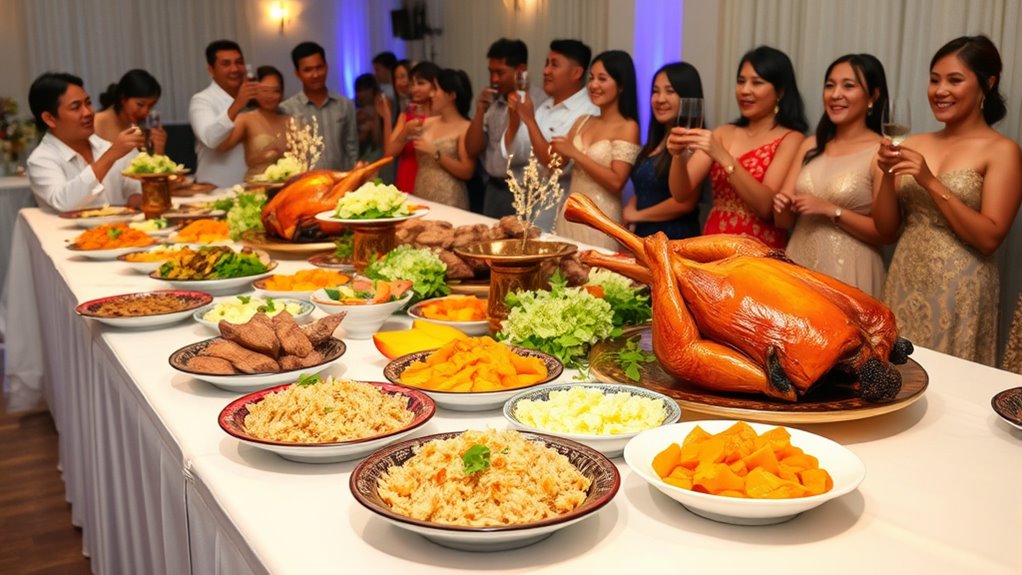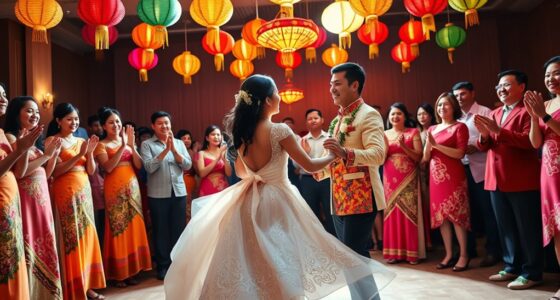Food plays an essential role in Filipina wedding celebrations, symbolizing love, unity, and prosperity. Traditional dishes like lechon and pancit connect guests with rich cultural heritage and shared experiences. Long noodles represent a long marriage, while the sharing of meals enhances the bond between the couple and their guests. The presentation adds to the festive atmosphere, making the celebration memorable. Discover more about menu planning and the significance of specific dishes to elevate your wedding feast.
Key Takeaways
- Food symbolizes unity and prosperity, with dishes like lechon and long noodles representing a fulfilling marriage and abundance.
- Traditional dishes enhance cultural significance, featuring favorites such as sinigang and pancit to celebrate Filipino heritage.
- Shared meals during wedding ceremonies, like the veil and cord ritual, emphasize togetherness and partnership.
- Food presentation plays a vital role, using colorful arrangements and garnishes to create an inviting and festive atmosphere.
- Catering services specializing in Filipino cuisine ensure authenticity, offering customizable menus to cater to diverse tastes and dietary preferences.
Traditional Filipino Wedding Dishes
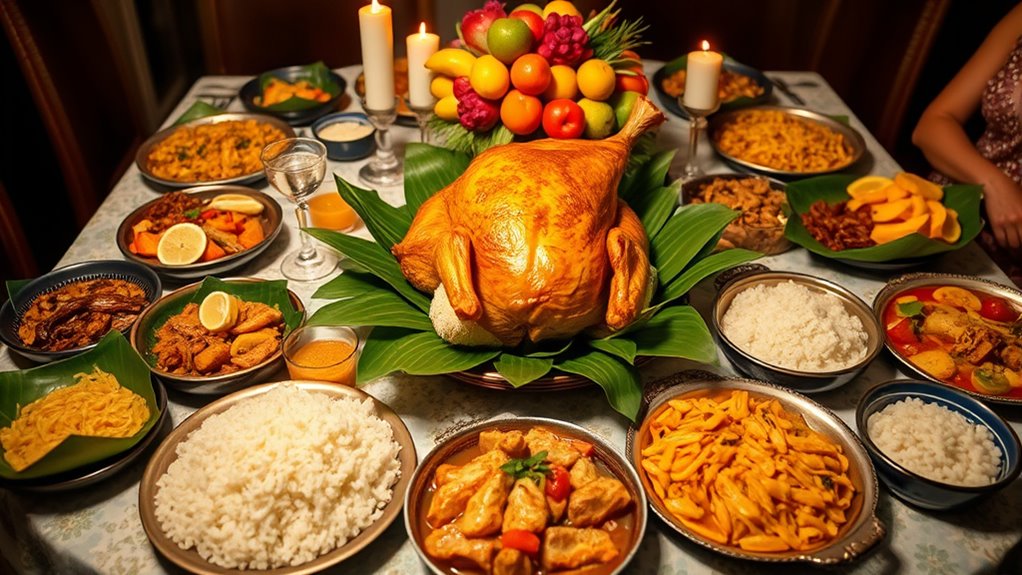
When you think of a Filipino wedding, the first thing that likely comes to mind is the incredible food that brings everyone together.
The centerpiece is often Lechon, a whole roasted pig, symbolizing celebration and prosperity. You’ll also savor Pancit Canton, a delicious noodle dish that blends Chinese and local flavors.
Sinigang Na Baboy, a savory pork stew, is perfect for large gatherings, while Caldereta serves up a hearty beef stew in a rich sauce. Don’t forget about Lumpiang Shanghai, crispy spring rolls that kick off the feast.
Other favorites like Adobo and Pancit Bihon make appearances, along with mouthwatering barbecue. Each dish reflects the warmth and joy of Filipino culture, making weddings truly unforgettable.
The Symbolism of Food in Weddings
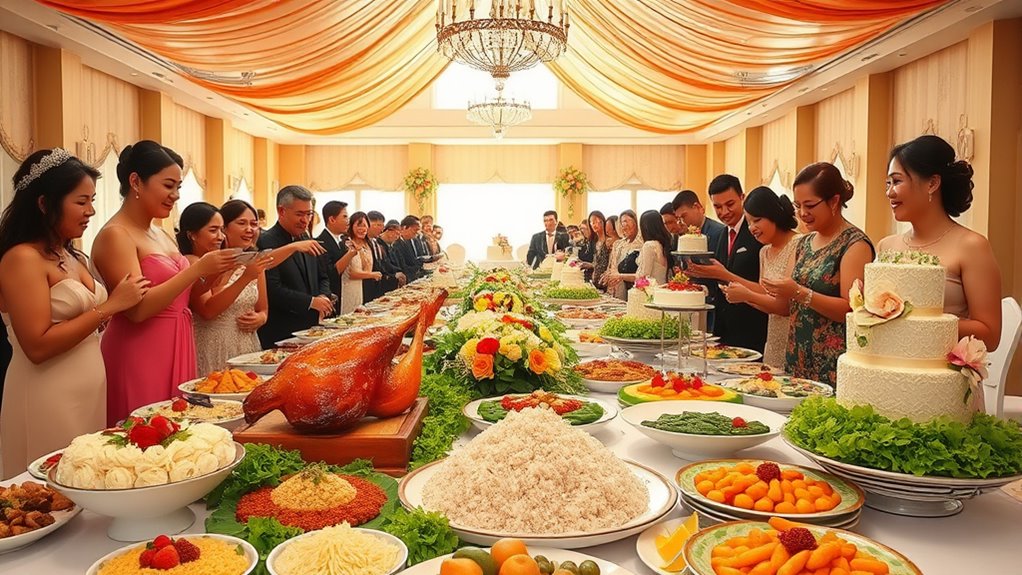
Food at Filipino weddings isn’t just about satisfying hunger; it carries deep symbolism that reflects the couple’s journey and cultural heritage. Long noodles in pancit symbolize a long and fulfilling marriage, while sticky rice represents unity and togetherness. Certain dishes are chosen for their ability to attract prosperity and good fortune.
Traditional foods showcase cultural roots, often integrating Chinese influences. During the veil and cord ceremony, food enhances the theme of unity through shared meals. Guests actively participate, fostering community bonding.
Rice, historically significant, symbolizes blessings poured over the couple. These culinary traditions not only preserve heritage but also strengthen emotional ties, ensuring joy and festivity as families and friends gather to celebrate love and connection.
Menu Planning and Course Selection
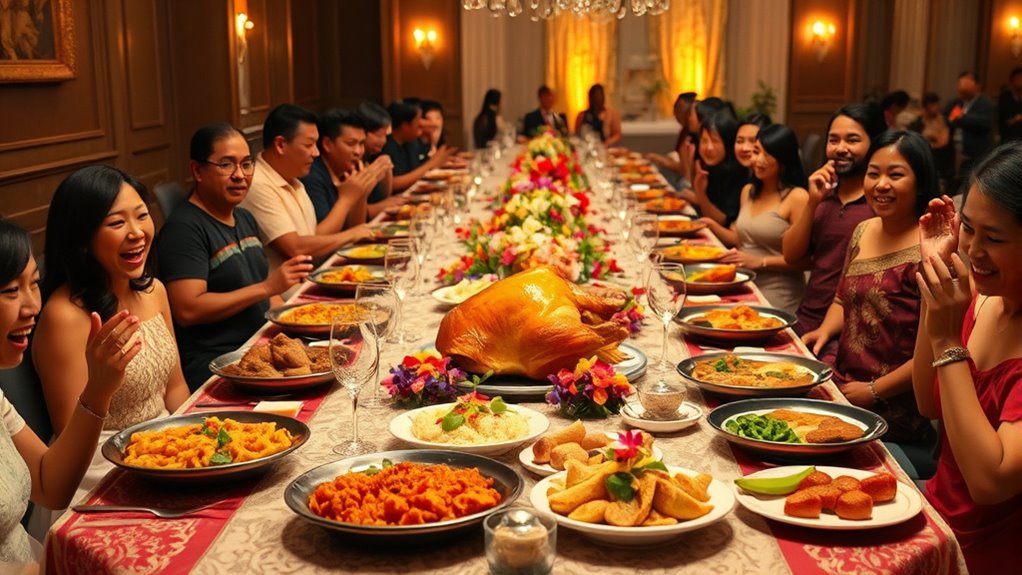
Crafting the perfect menu for a Filipino wedding requires thoughtful consideration of the couple’s tastes and cultural traditions. Start with traditional dishes like lechon, which serves as a centerpiece, and adobo for its tangy, savory appeal.
Crafting a Filipino wedding menu blends tradition with personal taste, featuring lechon and adobo as delightful highlights.
Incorporate regional delights like Pampanga-style BBQ, alongside popular appetizers such as lumpia and kinilaw. Diversify the main course with sinigang and add noodles like pancit bihon for variety.
Consider seafood options like rellenong pusit to delight guests. Don’t forget the essential side dishes—garlic rice and atchara pair beautifully.
For dessert, halo-halo ice cream offers a revitalizing finish. Be mindful of dietary restrictions by including vegan and vegetarian options, ensuring that everyone feels included at the celebration.
The Importance of Food Presentation
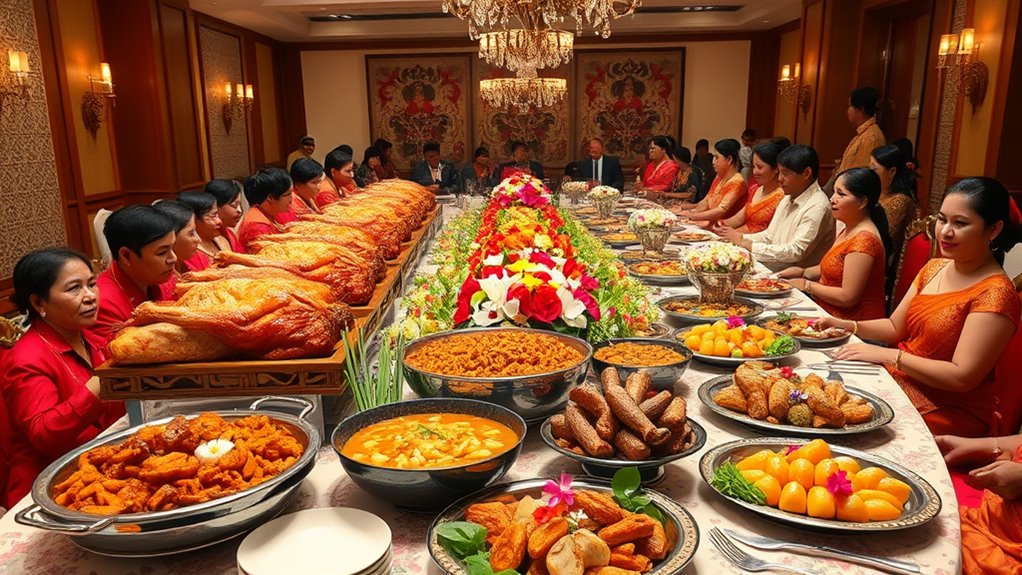
While planning a Filipino wedding, you’ll quickly realize that food presentation plays an essential role in enhancing the overall experience. The visual appeal of colorful dishes not only delights the eye but also reflects cultural values of abundance and hospitality.
Traditional garnishes like fresh herbs and edible flowers elevate each dish, while decorative platters create an inviting atmosphere. Symbolic foods, such as long rice noodles (pancit), are artfully arranged to emphasize meanings of longevity and prosperity.
Customized displays and attention to detail guarantee a cohesive look that fits your wedding theme. Plus, the festive environment encourages guest engagement, making the food a centerpiece of celebration and connection, perfectly capturing the essence of Filipino culture.
Catering Options for Authenticity
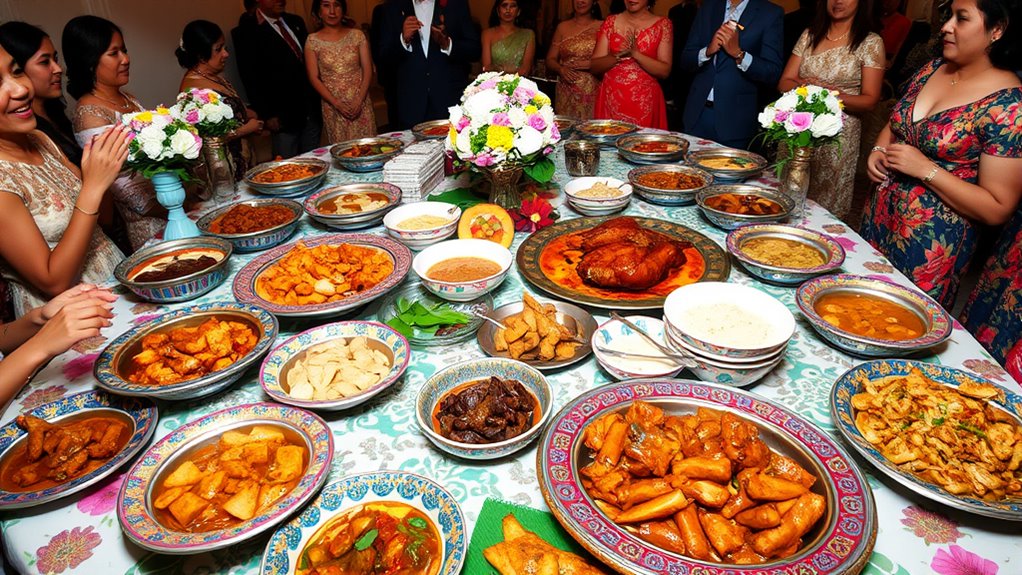
Selecting the right catering options is key to guaranteeing authenticity in your Filipino wedding. You’ll want to include traditional dishes like lechon, which symbolizes good luck, and pancit, representing long life.
Adobo and caldereta add rich flavors, while rice remains a staple at every meal. Don’t forget kare-kare, sisig, lumpia, sinigang, and tinola for variety and to cater to different tastes.
Consider partnering with catering services like Lola’s Filipino Kitchen or Juan Carlo, who specialize in Filipino cuisine and offer customizable menus to fit dietary preferences.
Tasting sessions can help you guarantee satisfaction with your menu, making your wedding feast a heartfelt reflection of your heritage and a celebration of unity among your guests.
Budgeting for Wedding Food
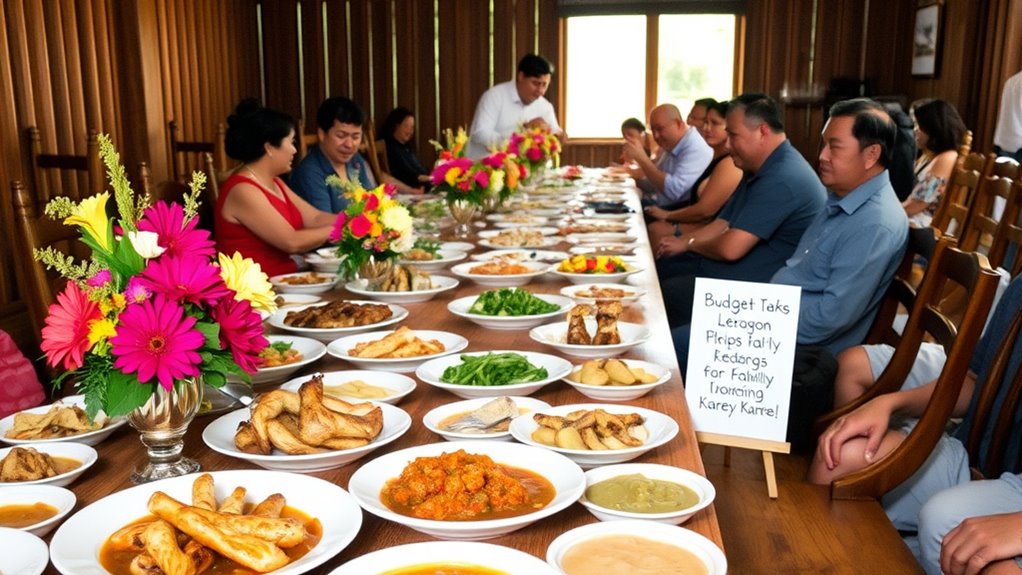
Budgeting for wedding food can be a challenging task, but with careful planning, you can create a memorable feast without breaking the bank.
Start by determining your cost per plate; expect to spend at least Php 300, with mid-sized weddings ranging from Php 500 to Php 1,000.
Prioritize your budget by focusing on main courses while considering budget-friendly appetizers like Lumpiang Shanghai. Incorporating local dishes such as Lechon can impress guests without inflating costs.
Don’t forget venue rental fees, which can range from Php 5,000 to Php 10,000. Also, remember to include meals for suppliers, typically costing between Php 120 to Php 250 per head.
Thoughtful menu planning is key to keeping your food budget in check. Additionally, consider setting specific savings goals to ensure you allocate enough funds for your wedding feast.
Cultural Significance of Shared Meals
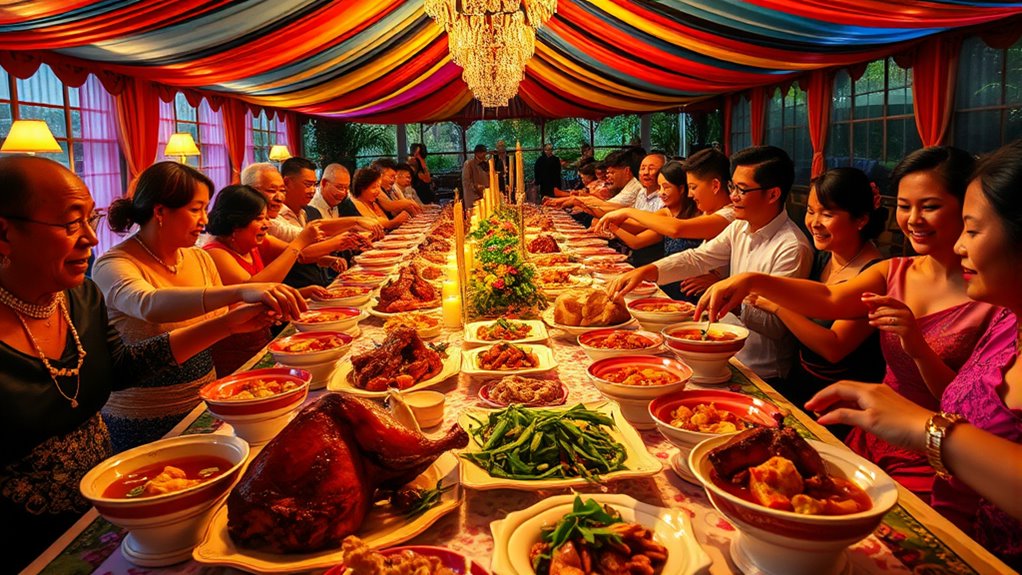
Shared meals play an essential role in Filipino wedding celebrations, as they symbolize abundance and the union of families. Historically, these meals have roots in pre-colonial traditions where a *babaylan* officiated marriage ceremonies that included sharing food.
This ritual not only signifies unity but also fosters community involvement, strengthening the bonds among families and clans. The diverse Filipino wedding cuisine reflects various cultural influences, from Spanish to Indigenous, showcasing the country’s rich heritage.
Traditional dishes like lechon, adobo, and pancit represent warmth, hospitality, and good fortune. When guests partake in these meals, they participate in blessing the couple, reinforcing the idea that food is a powerful connector in celebrating love and community.
Enhancing the Celebration With Food
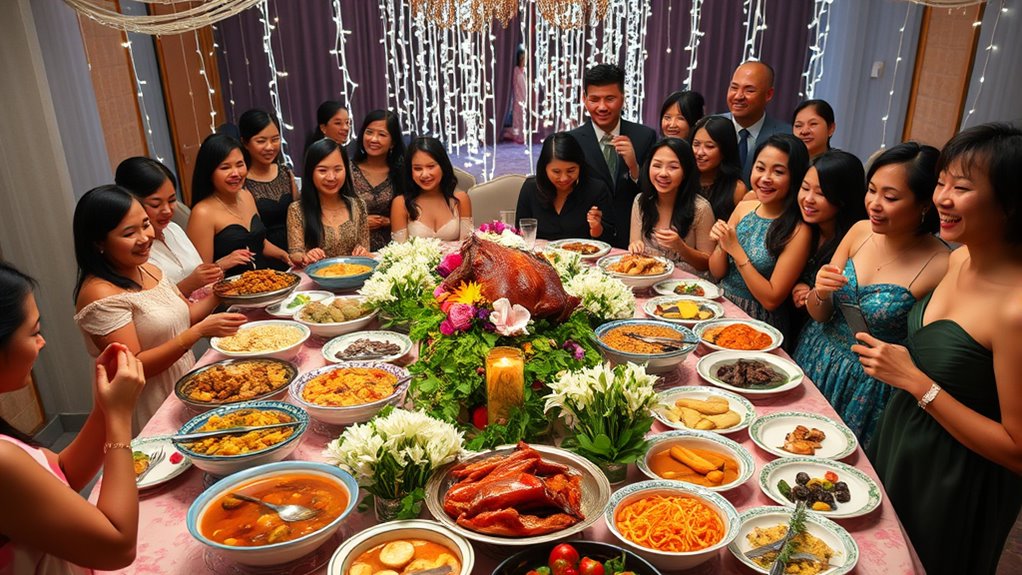
While food plays a pivotal role in any wedding celebration, it becomes particularly essential in Filipino weddings, where it enhances the overall experience for guests.
Traditional dishes like Lechon, Pancit, and Adobo create an inviting ambiance, while the aromatic scents of Sinigang Na Baboy and Caldereta draw everyone together.
Eye-catching food displays not only please the palate but also serve as conversation starters, fostering connections among guests. Shared tables promote social interaction, and interactive food stations keep the celebration engaging.
By catering to diverse tastes and dietary needs, you guarantee everyone feels included.
Ultimately, these culinary choices create lasting memories, evoke nostalgia, and elevate the joy of the occasion, making your wedding truly unforgettable.
Frequently Asked Questions
What Are Popular Drinks Served at Filipina Weddings?
At Filipina weddings, you’ll find a delightful array of drinks to keep guests refreshed.
Popular choices include the vibrant berry mojitos and the classic halo-halo, which combines shaved ice and mixed fruits.
You might enjoy fresh buko juice for a tropical touch or a zesty calamansi juice.
For a non-alcoholic option, try the sweet sago at gulaman.
Each drink adds a unique flavor to the joyous celebration, making it memorable for everyone.
How Does Food Vary Between Regions in the Philippines?
Food in the Philippines varies considerably by region, reflecting local ingredients and culinary traditions.
In Northern Luzon, you’ll enjoy hearty dishes like *bagnet* and *empanada*.
Central Luzon often features savory delights like *sisig* and *sinigang*.
If you’re in Bicol, expect spicy flavors with *Bicol Express*.
Meanwhile, the Visayas offers grilled seafood and roast pig.
Each area celebrates its unique flavors, showcasing the rich diversity of Filipino cuisine in every meal you savor.
Are Vegetarian Options Available in Traditional Filipino Wedding Menus?
Yes, vegetarian options are increasingly available in traditional Filipino wedding menus.
You’ll find dishes like vegan atcharang papaya, ensaladang talong, and lumpiang gulay, catering to diverse dietary needs.
While traditional meats like lechon are still prominent, modern weddings embrace inclusivity by adapting recipes for vegetarian guests.
This shift not only reflects changing preferences but also enhances the overall dining experience, ensuring everyone at the celebration feels welcomed and satisfied.
What Role Does Dessert Play in Filipino Wedding Celebrations?
Desserts at Filipino weddings symbolize joy and togetherness, marking the sweet conclusion of a festive meal.
You’ll find that desserts create memorable experiences, inviting guests to indulge in both tradition and flavor.
Sharing these treats fosters social bonds, reflecting the warmth of Filipino hospitality.
As you savor each bite, you connect with cultural heritage, ensuring that generations of family recipes continue to delight and unite everyone gathered to celebrate love.
Can Food Allergies Be Accommodated in Filipino Wedding Catering?
Yes, you can accommodate food allergies in Filipino wedding catering.
Start by selecting a caterer experienced with allergen-friendly options. Clearly label dishes and provide a menu that includes safe choices.
Communicate with your guests about their dietary needs in advance, and consider creating buffer zones at buffets for allergy-safe food.
Training your staff on food allergies is essential, ensuring everyone enjoys the celebration without worry.
Your careful planning will show your guests you care.
Conclusion
In Filipino weddings, the food you choose isn’t just about taste; it’s a celebration of culture and community. The theory that shared meals strengthen bonds holds true, especially in these joyous gatherings. When you savor traditional dishes, you’re not just feeding your guests; you’re weaving together stories and traditions. So as you plan your menu, remember that every bite can enhance the celebration, creating lasting memories rooted in love and shared heritage.
